
Persian Buttercup: A Colorful Beauty for Every Garden
japanchildrenrights.org – The Persian Buttercup (Ranunculus asiaticus) is a stunning flowering plant celebrated for its vibrant, multi-layered blooms and graceful form. Native to the Mediterranean region, it has become a favorite in gardens around the world due to its striking colors and ability to brighten up any space. Often grown as a bulb or tuber, the Persian Buttercup produces an array of flowers in shades of red, yellow, pink, orange, and white, making it a versatile and attractive addition to both indoor and outdoor gardens.
Physical Characteristics
Persian Buttercup is a herbaceous perennial that typically grows to a height of 12 to 18 inches (30 to 45 cm). It features finely divided, lacy foliage that provides an elegant backdrop for its large, showy flowers. The blooms are notable for their dense, ruffled petals, which resemble a rose or peony in appearance, giving the plant a luxurious, full-bodied look. Each flower can have up to 30 petals, adding to its stunning visual appeal. The flowers usually bloom in spring or early summer, lasting for several weeks before the plant goes dormant in the fall.
Growing Conditions
Persian Buttercup thrives in full sun to partial shade and prefers well-drained soil with a slightly acidic to neutral pH. These plants are typically grown from tubers, which should be planted in early spring, a few weeks before the last expected frost. It is important to plant the tubers in a location that receives at least 6 hours of sunlight per day to ensure the flowers develop fully. The plant prefers moderate moisture and should be watered regularly, but the soil must be well-drained to prevent waterlogging, which can cause tuber rot. Persian Buttercup can be grown in garden beds, containers, or as part of a mixed flower display, and it is especially popular for its ability to bring color to spring and early summer landscapes.
Uses in Gardening and Landscaping
The Persian Buttercup’s bright, eye-catching flowers make it an excellent choice for garden beds, borders, and containers. It pairs well with other spring-blooming flowers like tulips, daffodils, and hyacinths, creating a colorful, layered effect in the garden. Due to its relatively compact size, it is also well-suited for window boxes, hanging baskets, and pots, adding color to balconies or patios. Persian Buttercup is a great addition to cut flower arrangements, as its blooms have a long vase life, making it a popular choice for florists and garden enthusiasts alike.
Health and Medicinal Benefits
While Persian Buttercup is admired for its beauty, it is important to note that it is not commonly used for medicinal purposes. The plant belongs to the buttercup family (Ranunculaceae), many of which contain toxic compounds, particularly in the leaves, stems, and roots. Ingesting any part of the plant can cause skin irritation or gastrointestinal distress. For this reason, Persian Buttercup should be handled with care, especially around children and pets. It is best to avoid using the plant for any medicinal applications and instead appreciate its ornamental value in the garden.
Ecological Importance
Although Persian Buttercup is primarily grown for its aesthetic appeal, it does play a role in supporting local ecosystems. The plant’s flowers attract bees, butterflies, and other pollinators, contributing to the biodiversity of a garden or landscape. These pollinators help with the reproduction of not only Persian Buttercup but also many other plants in the area. The plant’s dense blooms also provide temporary shelter and food for small insects, further enhancing its ecological value.
Conclusion
Persian Buttercup is a captivating and colorful flower that brings elegance and beauty to any garden. Its lush, ruffled blooms in a variety of shades, combined with its compact growth habit, make it an excellent choice for gardeners seeking to add a touch of luxury to their outdoor spaces. Whether planted in garden beds, containers, or used as part of floral arrangements, the Persian Buttercup offers both visual appeal and a touch of Mediterranean charm. While it requires proper care and attention to thrive, the stunning blooms make it a rewarding addition to any garden, providing vibrant color and attracting pollinators.


